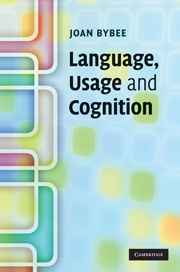Book contents
- Frontmatter
- Contents
- List of figures
- List of tables
- Acknowledgements
- 1 A usage-based perspective on language
- 2 Rich memory for language: exemplar representation
- 3 Chunking and degrees of autonomy
- 4 Analogy and similarity
- 5 Categorization and the distribution of constructions in corpora
- 6 Where do constructions come from? Synchrony and diachrony in a usage-based theory
- 7 Reanalysis or the gradual creation of new categories? The English Auxiliary
- 8 Gradient constituency and gradual reanalysis
- 9 Conventionalization and the local vs. the general: Modern English can
- 10 Exemplars and grammatical meaning: the specific and the general
- 11 Language as a complex adaptive system: the interaction of cognition, culture and use
- Notes
- Bibliography
- Index
7 - Reanalysis or the gradual creation of new categories? The English Auxiliary
Published online by Cambridge University Press: 05 June 2012
- Frontmatter
- Contents
- List of figures
- List of tables
- Acknowledgements
- 1 A usage-based perspective on language
- 2 Rich memory for language: exemplar representation
- 3 Chunking and degrees of autonomy
- 4 Analogy and similarity
- 5 Categorization and the distribution of constructions in corpora
- 6 Where do constructions come from? Synchrony and diachrony in a usage-based theory
- 7 Reanalysis or the gradual creation of new categories? The English Auxiliary
- 8 Gradient constituency and gradual reanalysis
- 9 Conventionalization and the local vs. the general: Modern English can
- 10 Exemplars and grammatical meaning: the specific and the general
- 11 Language as a complex adaptive system: the interaction of cognition, culture and use
- Notes
- Bibliography
- Index
Summary
Approaches to reanalysis
The study of grammaticalization has shown that new grammatical markers and constructions come into being gradually over time, through the operation of various reductive processes, as well as processes of inference in context. These gradual changes have the effect of creating new grammatical categories or new members of categories, and what could be viewed as new ‘rules’ or conventions of grammar. The creation of new grammatical structures is often called ‘reanalysis’. Reanalysis is usually viewed as an abrupt, but covert, change in the grammar that may not have any immediate overt effects (Langacker 1978, Lightfoot 1979, Kroch 1989a, Harris and Campbell 1995, Haspelmath 1998, Janda 2001, Roberts and Roussou 2003, Van Gelderen 2004). It is this view that requires a discontinuity in the transmission of language across generations (Andersen 1973); the child has access only to the surface forms of the language and not to the adult grammar and may therefore formulate a grammar that differs in structure from the adult grammar. As mentioned in Chapter 6, Janda 2001 argues that the discontinuity between generations makes some aspects of grammaticalization – such as unidirectionality – implausible and unexplainable.
The gradual nature of grammaticalization and the lack of evidence for abrupt reanalysis suggest that rather than postulate covert, inherently unobservable changes, we revise our conception of synchronic grammar so that it is more in line with the facts of grammatical change.
Information
- Type
- Chapter
- Information
- Language, Usage and Cognition , pp. 120 - 135Publisher: Cambridge University PressPrint publication year: 2010
